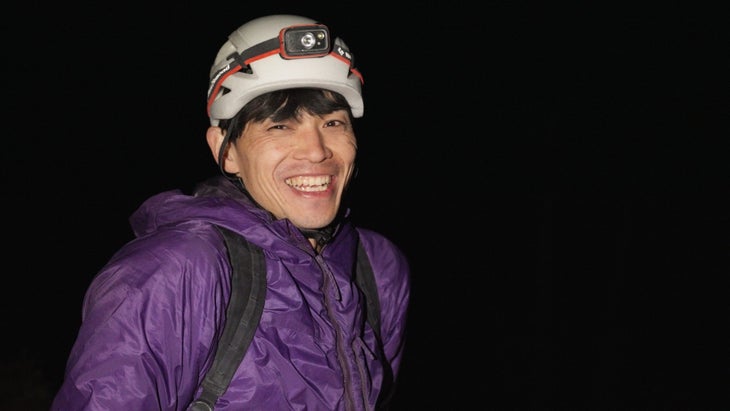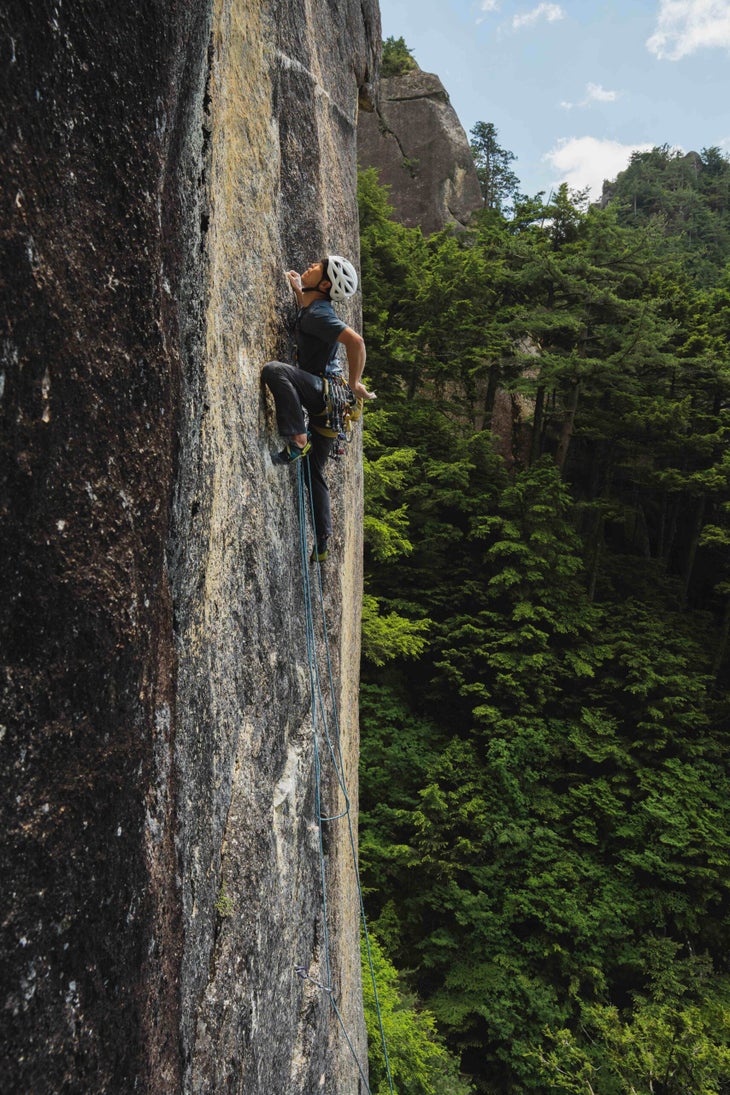
“Should I prioritize saving my life, or should I prioritize climbing? When I thought about it, I became convinced climbing was an essential part of my life.”
The post Remembering Keita Kurakami, Renowned Japanese Trad Climber appeared first on Climbing.

Japanese rock climber Keita Kurakami passed away on June 26, following a heart attack on Mount Fuji (12,388ft). Kurakami was 38 years old. He is survived by a wife, older brother, mother, and father.
Kurakami was a steel-nerved climber at home in Japan, pioneering necky trad routes like The Votive Light (5.13d/14a R) and Pass It On (5.14+ R). He also sent hard sport, notably The V (5.14d/15a), Isono Namihei (5.14+), and Mare (5.14c). The latter, which he rope-soloed in 2019, is likely the world’s hardest lead rope-solo free ascent. Kurakami also pioneered a spread of sketchy highball boulders, usually ground-up (and, in trademark style, seldom graded).
Outside of the Japanese climbing scene Kurakami was best known for free climbing El Capitan’s 3,000-foot Nose (5.14a) in 2017. At the time, climbing media lauded Kurakami as the fifth person to free the route, but he disputed the idea, as he and partner Yusuke Sato did not send ground up, in a continuous push, and instead redpointed each pitch individually, some out of order. “[Some people say] my ascent can be accepted free ascent, even so, if I have doubts myself, I can’t agree with it,” he wrote at the time. “I will come back again to climb it in better style.”
(True to his word, Kurakami returned in 2018. He not only freed the route ground up, but did it rope-solo, self-belaying using a GriGri+ on an 8.1mm rope. He was the first person to rope-solo free the route, and it was reportedly his first time rope soloing a big wall.)

Damn the torpedoes missions like these were characteristic of Keita Kurakami’s climbing story. If there was any common theme among the rocks that captured his imagination, it was clearly objectives that were scary, hard, and pure. Among his boldest efforts was the first ascent of seven-pitch Senjitsu-no Ruri (5.14a R/X) on the Moai Face of Mt. Mizugaki, which he completed in 2015 with Sato. The pair swapped leads, with Kurakami leading the two hardest pitches, 5.14a R and 5.13d R/X. The 820-foot line was rife with microscopic protection and entailed runouts of up to 65 feet.
In a masterful essay for Alpinist about his ascent, Kurakami recalled how he peeled off the wall into a 30-foot whipper while working the route, severely injuring his ankle. “Even the injury seemed preferable to the dullness I’d felt in the past when I rehearsed problems countless times,” he wrote. “This time, right at that threshold between adventure and recklessness, I could feel the reality of the moment I sought.”

Kurakami suffered from an exercise-induced variety of vasospastic angina (VSA), a cardiac condition which first impacted him in 2021. While out mountain biking with friends, the 35-year-old Kurakami’s heart stopped, and he tumbled from his bicycle. He was in cardiac arrest for nearly 20 minutes before being revived in an ambulance.
In subsequent days, doctors told Kurakami to stop climbing, and recommended he have an implantable cardioverter-defibrillator (ICD) installed in his chest to mitigate subsequent cardiac events. Approximately 99% of patients with the same condition do so.
The surgery, however, would have meant that Kurakami would be unable to raise his arm above his shoulder for the rest of his life, effectively ending his climbing career. “After I regained consciousness there, for about three days I just kept thinking, ‘Should I prioritize saving my life, or should I prioritize climbing?’” Kurakami told Japanese sports magazine Number in 2022. “When I thought about it, I became convinced that climbing was an essential part of my life.” He chose not to receive the surgery.
Though Kurakami’s wife, brother, and parents initially fought his decision, they ultimately agreed to his wishes. “I thought giving up climbing would be a choice I would regret later on,” Kurakami explained. “Even if I lived to be 70 or 80 without climbing, would that really be a happy life for me?”
“I don’t want to die,” he elaborated, “but I accept that … you don’t know which way it will go. In the end, I don’t want to regret my choice, and it’s about which choice makes my heart flutter. If you are facing in the direction that makes your heart flutter, everything will tend to be positive.”
In fact, Kurakami seemed to indicate that there was a silver lining to his health struggles. He said he found it meaningful to push through challenges of all kinds, whether a hard rock route or a fatal heart condition. “Facing my heart disease and climbing are exactly the same for me,” he said. “The process and what I seek are the same. If you ask what has given me a sense of fulfillment in my life, climbing and heart disease would definitely be in my top three.”

Climber and filmmaker Takemi Suzuki met Kurakami in 2016, after the latter’s daring work on Senjitsu-no Ruri made waves around Japan. Suzuki said, unequivocally, that the footage of Kurakami on that route changed his life. “He climbed like an insect, with no secure protection,” he said. “I was shocked to see it. This was the climb everyone looked up to and said was beautiful, but no one had ever even considered to try it.”
The pair remained in touch over the years, and Suzuki began photographing and filming Kurakami’s climbing in 2020, beginning with the 5.14+ R Pass It On. Suzuki recalled a friend who was loyal, kind, funny, and compassionate, but who became totally severe when it came to climbing—both regarding his own ethics and training, and also who he roped up with. “Rather than being friendly with everyone and going out climbing with various people, he only tied ropes with certain people,” Suzuki said.
He fondly remembered a day when he went to film Kurakami bouldering. It was the rainy season, conditions were bad, Kurakami had no crash pad (this was apparently common), and the V6 he was aiming for had a sketchy fall-zone, jammed with sharp rocks. There had been several injuries on the climb in the past, and those from parties using a pad. “I was worried, and asked if it was really okay,” Suzuki recalled. After thinking for a moment, Kurakami kicked the jagged granite rocks below the climb and answered deadpan, “These rocks are soft. So it’s okay.”

Suzuki was quick to clarify, however, that Kurakami didn’t have a death wish. After his heart attack, Kurakami studied the cardiovascular system so deeply he was practically a medical student, and began following a rigorous dietary therapy to keep his heart as healthy as possible. In recent years, “his health had actually improved greatly,” Suzuki said, “and his climbing performance improved too.” When Kurakami told friends he was fully recovered, they believed him.
Kurakami became the third person to free rope-solo a route on El Cap when he climbed the Nose in 2018. Pete Whittaker, who met Kurakami in the Valley the following year and had climbed in the same style on Freerider (VI 5.12d), told Climbing that he and Kurakami joined forces for some climbing. “He had a good sense of humor and was incredibly kind and humble,” Whittaker said. “Not to mention he was an outrageously talented climber.”
The pair left the Valley with plans to climb together again, but never managed to link back up due to Kurakami’s heart condition. They stayed in touch over the years, and Whittaker said he “was always really impressed by the climbing [Kurakami] was doing back home in Japan. He didn’t follow the same path as everyone else, and pursued interesting and scary looking ideas, such as first ascents ground up—mossy, highball first ascents. Who else does that? He was one of a kind.”
Whittaker and Kurakami had plans to climb together again this year, along with Suzuki. Kurakami died just three weeks before their trip.

American climbing photographer Drew Smith, who also met Kurakami in the Valley in 2019, said that even though the pair only spent a brief time together, Kurakami’s style and ethos had a major impact on him. Smith photographed Kurakami rope soloing on Zodiac (VI 5.13d). “I could tell the climbing was very hard, both difficulty-wise and mentally, with big run outs and not great protection,” Smith said. “[But] he was very calm and you could tell he really enjoyed the process and challenge.”
“Keita’s style was very pure,” Smith continued. “We went bouldering, and he would wander off and I would see him climbing a hard boulder with no pad, or he would walk away and start playing his flute. He was his true self, and doing things in such a pure way … His actions and the way he carried himself [are something] I’ll value and remember forever.”
Japanese climber Yohei Nomiyama, who met Kurakami at the crag in 2018, said Kurakami was like a brother to him, “not only in climbing, but also in life.” He was always struck by how careful and mindful Kurakami was during any project. “When he climbed, he even treated things around [the] rocks as precious, such as a short skinny tree [near] a boulder.”
Nomiyama said Kurakami’s climbing was characterized by a deep respect for—and acceptance of—what nature provided him, both in his body and on the rock. “I believe that his achievements, which are creative and absolutely free, came from his serious attitude for the rocks,” Nomiyama said. “I’ll keep walking the path, embracing what he taught me—being fair, clean, and free. In his climbing, and in his life, Keita always loved going ‘ground-up.’”
Takemi Suzuki said his friend operated under a motto: Break your bones, but don’t break your heart. This spoke to Kurakami’s ethics, which were deeply rooted in climbing tradition and heritage. Kurakami believed it was his “mission” as a modern-day rock climber not to merely push the difficulty barrier, but to do so without compromising the style of his forebears.
“He knew that anyone could try a route safely if he put many bolts,” Suzuki remarked. “However, he felt this was an insult to the climbing culture built by his predecessors… When faced with fear or difficulties that would frighten anyone, most normal people would choose the easier way out, or give up on the challenge altogether, making up some excuse for it, saying, ‘It can’t be helped.’ Keita faced those fears and difficulties with sincerity until the very end.”
In his Alpinist essay, Kurakami recalled a time when he asked an alpinist he looked up to about the difference between a sport route and an alpine route. “Looking back, I’m embarrassed at how ill-mannered a question that was,” Kurakami wrote. “If I’d properly observed and understood his climbing, I would have already known the answer.” The alpinist responded that the difference was: “Whether it is still possible to cross the line between the places you can return from, and the ones you can’t.” It is clear Kurakami attempted to bring this measure of “alpinism” into all his climbing, from 15-foot boulders to 3,000-foot big walls.
Suzuki said Kurakami’s refusal to compromise, whether he was eschewing protection on runout climbs or turning down a medical procedure that could have saved his life, were all manifestations of this die-hard sense of ethics. Not wanton recklessness, but a staunch refusal to let the fears and anxieties of mortality grind him down.
“He chose to live as Keita Kurakami until the end.”
The post Remembering Keita Kurakami, Renowned Japanese Trad Climber appeared first on Climbing.